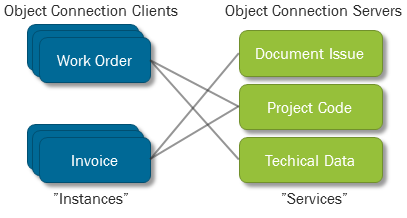Object Connections¶
Object connections are special relations between two logical units where one of the logical units (entities) is of general type and may therefore be handled as "public" or "global". Another view of the situation is that common business objects may be connected to general global services in the business area.
These relations/connections can be seen in the object model of the business classes as being modeled having default connections (since they can be changed in runtime and get connected with other services). Examples of general services are: document connections, project awareness or technical data information.
The difference between object connections and associations is that object connection are dynamic (can be defined in runtime) and don't create dependencies between components.
Uses¶
An object connection server is a logical unit which behaves like a global service to be connected from several other logical units (object connection clients) in a business application. Note that these servers are registered in the presentation layer by being modeled within Developers Studio as entities with the codegenproperty ObjectConnectionService. The entity acting server must contain two attributes named KeyRef and LuName. Example: DocReferenceObject
An object connection client is a logical unit whose instances (records) may be connected to some kind of global service (object connection servers). Note that these clients are registered in the server side business logic at install-time by being modeled within Developers Studio using the objectConnections section, defining a service (or several) which becomes the preferred server objects (shown in Object Connection Default Definitions within Solution Manager). The connection may be changed by the Object Connections client within Solution Manager.
Example: DocFolder

Presentation Layer Behavior¶
- When registering object connection servers in the presentation layer, an Attachments tab (client) will be associated with the server. This client (tab) will be shown and used for registering of active object connections.
- The client that implements the needed logic for each registered server entity must be named using the following naming standards:
B2E:
Attachment.client (Example: DocReferenceObjectAttachment.client) B2B:B2bAttachment.client (Example: DocReferenceObjectB2bAttachment.client) - Pages using entities that are connected to use a object connection server will list each server as a tab at the end (bottom) of the page. Each tab will be dynamically instantiated with the page associated with the object connection server.